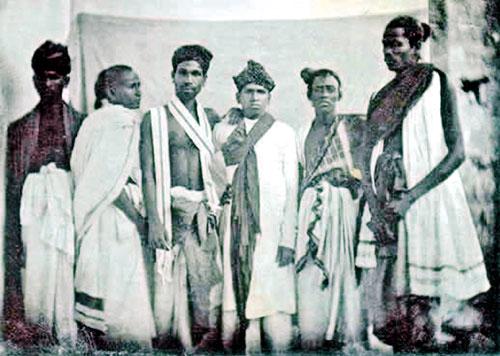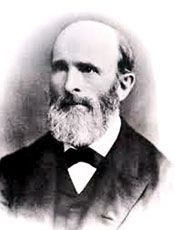The doctor whose legacy altered the medical landscape of then Ceylon

First batch: Dr. Green’s students in 1848
The lives of great men and women leave indelible marks on the pages of history. Dr. Samuel Fisk Green was an inspiring figure whose vision and legacy altered the medical landscape of the island of Ceylon in ways that he may not have fully comprehended at the time. On his 200th birth anniversary on October 10, it is only fitting to recall his legacy.
While a young medical student I had become very much aware of the significant contributions made by generations of American missionaries who had served in Jaffna and helped transform the social, cultural, educational and medical landscape of the peninsula in ways that are still evident. As a young doctor I had the great privilege of working in the hospital that Green founded and understanding even more the greatness of this man. He has long been an inspiration and a hero to me.
Today in the 21st century, international travel is not something most people think twice about. This was certainly not the case when the American missionaries first set out to travel to distant lands. They worked for the holistic transformation of society by sharing the very best of educational and scientific knowledge available to them. They also sought to address human suffering. They themselves were exposed to disease and bore great personal losses in their journey to Ceylon and during their life here.
Samuel Green set out for Jaffna in 1847. The journey took him four and a half months by ship but he used that time well by learning Tamil during the voyage.
Following his arrival in 1847, his acceptance and fame as a doctor followed his successful treatment of a well-known Tamil and Sanskrit pundit, Mr. Mutathamby, for a large abdominal abscess that had not responded to the ministrations of traditional practitioners. He was an extremely successful doctor who served and saved thousands of patients at Manipay and Jaffna, carrying out numerous operations with very basic or no anaesthesia – from cataracts to removal of tumours – some complex even by today’s standards including of the oral cavity, fixing of fractures, treating surgical infections and so on.

Dr. Samuel Fisk Green
He quickly observed and understood the main medical problems of his time: that oral cancer was common and that it was caused by the use of slaked lime on the betel leaves that people chewed and that diabetes and obesity was very evident. Infections such as cholera, smallpox, malaria and pneumonia were also diseases that he had to deal with.
Green understood that the needs for health care in the peninsula were far too much for him to provide on his own so he set about training young local men as doctors! He selected students who had studied in English and graduated from the Batticotta seminary (now Jaffna College) as his first students. In 1848 he established the first medical school in Ceylon at Manipay and thus also made his American Mission Dispensary the first teaching hospital in the island!
As he produced batches of students he was faced with new challenges. He was so successful in his efforts at producing locally trained doctors that the British colonial government promptly gave them jobs not just in Jaffna but outside as well. The quality of training resulted in producing doctors of excellent standard. Rev. B. Bailey, chaplain to the Bishop of Colombo, during a visit to Jaffna saw one of Green’s students working at the government hospital and stated that he possessed ‘acquirements equal to the majority of the young men who enter the medical profession in England’!
This resulted in many of Green’s graduates being posted outside Jaffna and Green’s solution was to teach medicine in Tamil so that the doctors trained would be better able to serve the local community and, hopefully, also remain in the area!
With the help of his Tamil students he proceeded to translate many of the medical books of his time into Tamil, including Cutter’s Anatomy, Physiology and Hygiene, Gray’s Anatomy, Maunsell’s Obstetrics, Druitt’s Surgery, Dalton’s Physiology and many more. The American Mission had already established the first printing press in the north which was also producing the second oldest newspaper in Ceylon, The Morning Star.
All in all, he trained 62 students of whom 33 were taught in Tamil. Besides them he had started another 20 well into their training before he finally left in 1873.
Such was Green’s reputation as a doctor that in addition to his work at the hospital in Manipay, he was requested by the British Government Agent of Jaffna, Percival Dyke, to help support a hospital in Jaffna town. Thus did the Friends in Need Society Hospital in Jaffna get Green’s help in becoming a well-established hospital in 1850. This was to be the forerunner to today’s Teaching Hospital in Jaffna. Green served as a visiting surgeon and Superintendent there for many years. His students served that hospital as doctors till 1907.
Ten years after arriving in Jaffna, Green returned to America, mainly due to his poor health after suffering from cholera. During the five years he was there he married Margaret Green and they returned to Jaffna in 1862. They had four children (three daughters and a son) during this stay in Jaffna. He continued his immense work of service and training during the next ten years he was there.
Green departed the shores of Jaffna for the last time in 1873 with the hope that he would return to continue his work but the American mission decided not to send him as they felt that his health was not good. The mission also decided to stop funding the medical school as the British had started a medical school in Colombo in 1870. Jaffna had to wait another hundred years for the establishment of a medical school, the Faculty of Medicine, in 1978!
Till his dying days Green’s thoughts were very much about Jaffna and its people. In his will he stated: ‘should I ever have a gravestone, let it be plain and simple, and bear the following inscription:
Samuel Fisk Green,
Medical Evangelist to the Tamils.
Jesus my all’
He died on May 28, 1884.
Searching for an ideal partner? Find your soul mate on Hitad.lk, Sri Lanka's favourite marriage proposals page. With Hitad.lk matrimonial advertisements you have access to thousands of ads from potential suitors who are looking for someone just like you.


